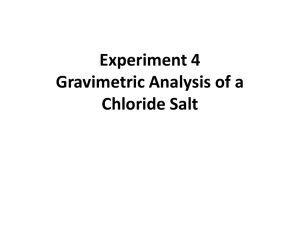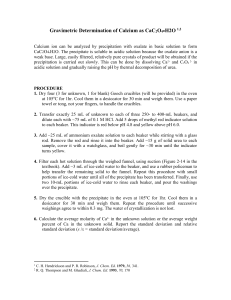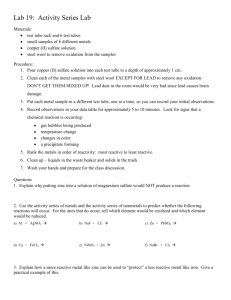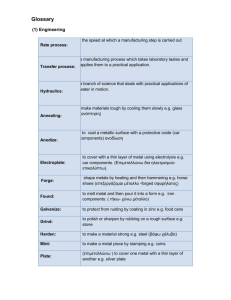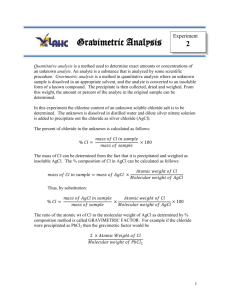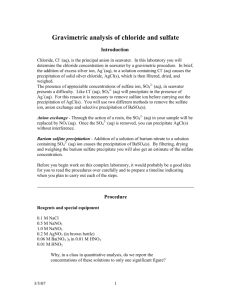Activity 1 - Newton.k12.ma.us
advertisement
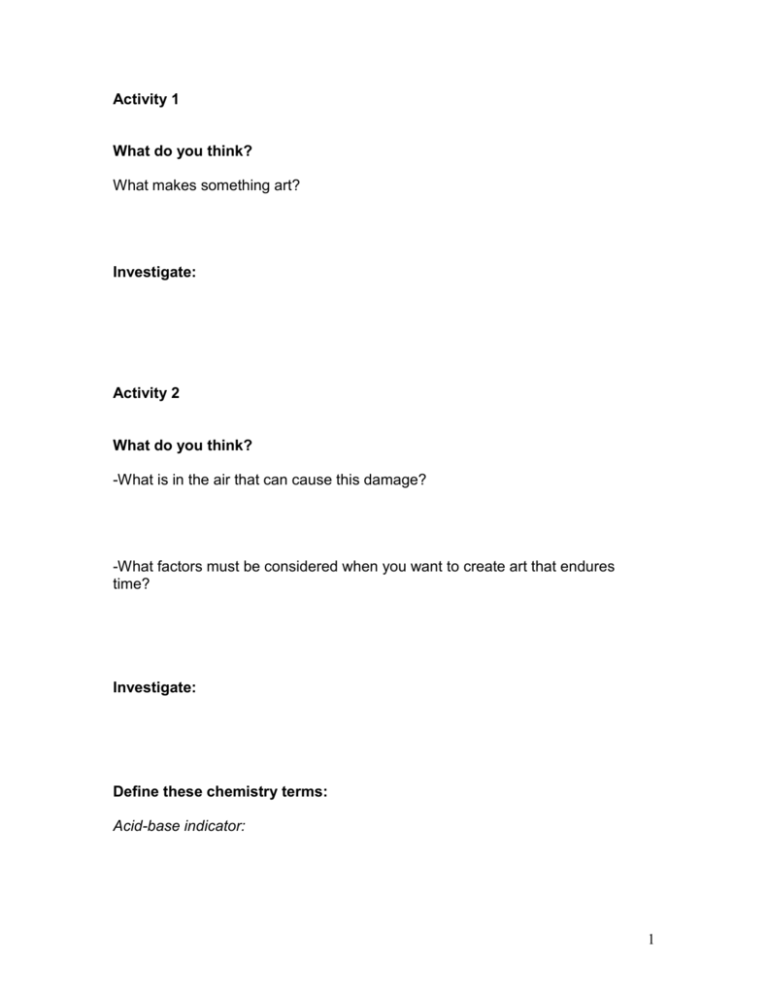
Activity 1 What do you think? What makes something art? Investigate: Activity 2 What do you think? -What is in the air that can cause this damage? -What factors must be considered when you want to create art that endures time? Investigate: Define these chemistry terms: Acid-base indicator: 1 Universal indicator: PH: Hydrogen ion (H+): Acid deposition: Acid rain: Checking Up: 1. How can you determine the pH of a solution? 2. Write a chemical equation for the reaction of CO2 with water. 3. Write the equation for the dissociation of sulfuric acid in water. 4. What is meant by the term “acid deposition”? 2 What does it mean? Chemistry explains a macroscopic phenomenon (what you observe) with a description of what happens at the nanoscopic level (atoms and molecules) using symbolic structures as a way to communicate. Complete the chart below in your Active Chemistry log. Macro Nano Symbolic *For macro, describe what you can see happen to an outdoor marble statue over time when it is placed in an area with high concentrations of acid in the atmosphere. *For nano, use words to describe what occurs on the molecular level as marble deteriorates over time in the presence of acid. *For symbolic, use chemical equations to describe what occurs as marble (CaCO3) deteriorates over time in the presence of hydrochloric acid (HCl). How do you know? What evidence do you have that acids form when carbon dioxide reacts with water and sulfur dioxide reacts with water? Why do you believe? Along the Ohio Valley there are large factories and giant coal-burning electrical power plants. Given that the prevailing winds travel from west to east, would you expect greater damage to an outdoor statue in New York or in the plains of Nebraska? 3 Why should you care? A complete description of your artwork should include its intended placement. Will it be in a museum or placed outside in the courthouse square? Careful consideration of what your work will be exposed to in the air will be an important part of your Chapter Challenge. Activity 3 What do you think? How might the properties of metals be related to the atomic structure of the metal’s atoms? Investigate: Define these chemistry terms: Valence Electrons: Octet rule: Patina: Electroplating; Checking Up: 1. How many valence electrons does an oxygen (O) atom have? 4 2. How many valence electrons does calcium (Ca) atom have? 3. What will be the typical charge on a calcium ion? How do you know? What evidence do you have to support the idea that one metal is more reactive than another? Use your data to explain how copper made its way onto nickel in Part C. Why do you believe? Report on a situation in your life where you would need to choose a less (or more) reactive metal for some everyday purpose. Why should you care? Understanding the reactivity of metals will help guide you as you create your work of art, should you choose to incorporate metal into it. The reasons may be for beauty or protection, but either way a meaningful explanation of your choice of metal will add credibility to your museum display. 5 Activity 4 What do you think? - How can the physical properties of metals be modified? - What properties of metals make them useful as works of art or tools for creating art? Investigate: Define these chemistry terms: Electron-sea module: Cation: Malleability; Alloy: Annealed steel: Hardened steel: 6 Tempered steel: Brass; Bronze: 7 Activity 4 (p. 201) What do you think? - How can the physical properties of metals be modified? - What properties of metals make them useful as works of art or tools for creating art? Checking Up: 1. Explain the electron-sea model. Draw a figure 2. What is meant by malleability? Chem to go ( p.209) 1. What are the differences in composition of bronze and brass? 2. What are the components of steel? List some different used for steel and explain why an alloy is better for the job. 8 3. Provide a summary of the formation and properties of each type of steel— annealed, hardened, and tempered. 4. Describe a use for each type of steel. 5. Is there a connection between the tools used for creating art and the technology of the time? Explain your answer. 6. Preparing for the Chapter Challenge Sculpting artworks has changed over time from simply carving out an image from some soft material to forming molds and casting to the use of high temperatures to weld metals together. Create a small sculpture either out of metal materials or some other material using a metal tool. What properties of the materials allowed you to create the effect you sought. 9 Activity 5 ( P.210) What do you think? - List as many ceramic materials and products as you can. - What are some properties of ceramic materials that make them so useful? - What are some properties of ceramic materials that can limit their usefulness? Investigate: 10 Define these chemistry terms: Hydrate: Anhydrate: Mole: Avogadro’s number: Molar mass: CHEM TALK All about moles 11 Checking Up: 1. What is a mole? 2. What is atomic mass? 3. What is the difference between a compound that is hydrated or anhydrous? 4. How many grams are there in 1.5 moles of water? 5. How many atoms are there is 2.6 g of gold? 6. How many molecules of platinum would weigh 100 g ? 7. How many moles are there is 88 g of CO2 ? 8. How many grams of water are there is 1 moles of MgSO4 . 7H2O 12 Chem to go act 5 (P.220) 1. Why do chemists use the unit moles? (research using resources on the web) 2. What is the gram-molecular mass of NaN3(s)? 3. What is the total number of moles of NaN3(s) in a 52-g sample of the compound? 4. A sample of a compound contains 65.4 g of zinc, 12.0 g of carbon, and 48.0 g of oxygen. What is the mole ratio (simplest formula) of zinc to carbon to oxygen in this compound? 5. A sample of a substance containing only magnesium and chlorine was tested in the laboratory and was found to be composed of 74.5% chlorine by mass. If the total mass of the sample was 190.2 g, what was the mass of the magnesium? 6. Kaolinite is a type of clay commonly used for making china. Its formula is Al2Si2O5(OH)4. Suppose you were given approximately 250 g of Kaolinite for creating an object. How many moles of kaolinite did you have? 13 7. You may have notices that most electronic equipment comes packed with small packets of desiccants (drying agents that pick up water molecules). Speculate about what you think these desiccants might be made of and why they are placed in packages electronic equipment. 8. In Part A, if the empty crucible was not heated long enough to completely dry it prior to weighting, what would be the effect on the calculated percent water in the unknown (larger or smaller)? Explain. 9. Explain how determining the percent composition of water might be useful to a potter. 10. Calculate the mass of water removed in forming the anhydrate from 3.22 g of Na2SO4. (10H2O) 11. Preparing for the Chapter Challenge Your challenge for this chapter involves the creation of a work of art. In Part C of this activity you made an object out of clay. How could you use this object in your final work of art? Consider the object and come up with some ideas for how you might add another element to the object to make it more useful or aesthetically pleasing. Take one of your ideas for adding on to the clay object and then do it. 14 Activity 6 What do you think? What are some desirable properties of a pigment? Investigate A: Precipitate Reactions In this activity you will mix different pairs of solutions. After mixing, you will observe whether the product is a solution, a solid precipitate, or both. FeCl3 FeCl3 iron (III) chloride NaOH Zn(NO3)2 Kl Na2CO3 NaCl K2SO4 CuSO4 X NaOH sodium hydroxide Zn(NO3)2 zinc nitrate Kl potassium iodide Na2CO3 sodium carbonate NaCl sodium chloride K2SO4 potassium sulfate CuSO4 copper sulfate 15 Mix the two solutions that coordinate with each box. (example, for the first set of reactions, you should mix FeCl3 with NaOH and record whether a solid precipitate is formed.) a) Why is an X noted in the first box? 1. The different solutions you will use are in dropper bottles. Using only one or two drops of each, react each solution with the others. Do not allow the tip of the dropper of one solution to come in contact with the other solution. a) If a precipitate forms, record its color in the table in your log by using the notation “Ppt (color)”. If no precipitate forms, record “Sol” (for solution) in the table. Define these chemistry terms Cation: Anion: Precipitate; Ionic Compound: Salt: Double-replacement Reaction: 16 Soluble: Insoluble: Simple rules for solubility of ionic compounds in water (do not copy from the text ) 17 Checking Up 1. Predict the products when the following aqueous solutions are combined; write the entire reaction as a word equation a) Copper sulfate plus sodium hydroxide b) Potassium iodide plus iron (III) bromide 2. Use the solubility rules to determine which of the following are insoluble in water. a) Lithium acetate b) Ammonium Chloride c) Silver Bromide d) Lead nitrate e) Sodium carbonate f) Mercury perchlorate g) Calcium hydroxide h) Ammonium sulfate i) Ammonium phosphate j) Silver chloride k) Barium sulfate l) Barium phosphate m) Strontium sulfate n) Strontium hydroxide 18 Chem to go ( p.231) 1. Describe the difference between salts that are water soluble, slightly soluble, and insoluble. 2. Which of the following compounds are soluble in water? a. NaOH b. CuCl2 c. PbSO4 d. KCl e. Mg(OH)2 3. Predict whether precipitation will occur when the following compounds in aqueous solution are combined. If so, what is the formula of the precipitate? a. Barium chloride + aluminum sulfate b. Silver nitrate + potassium chloride 4. Predict whether precipitation will occur when the following solutions are combined. If so, what is the formula of the precipitate? a. AgNO3 (aq) + KBr (aq) b. Na2SO4 (aq) + MgCl2 (aq) c. KOH (aq) + Fe(NO3)3 (aq) 5. Which set of compounds contains a salt that is insoluble in water? a. BaCl2, ZnCO3, LiOH b. Cs2SO4, KOH, MgBr2 c. (NH4)2SO4, LI3PO4, KC2H3O2 d. NaNO3, MgCl2, Li2CO3 19 6. Which of the following would most likely be a precipitate formed in a double replacement reaction? a. AgCl b. AgNO3 c. NaCl d. LiNO3 7. Which of the following shows the general equation of a double replacement reaction? a. AB + CD = ABCD b. AB + CD = BA + DC c. AB + CD = AD + CB d. AB = CD = AD + CD 8. If a solid forms from a double replacement reaction, it is called: a. Precipitate b. Reactant c. Product d. Pigment 9. In photography, silver halide (silver bromide or chloride) salts are used as described in the Why do you believe section. One way to produce AgCl is by reacting aqueous silver nitrate with aqueous potassium chloride. What is the other product of this reaction, and what are the “spectator” ions? 20 Activity 7 What do you think? -List some desirable properties of a dye. - Identify as many natural sources of dyes as you can. Part A: 1.There are two solutions, follow the directions for Part A. - Pour about 100 mL of the solution into a 150-mL beaker, the solution for your group is shown in the table shown on page 234 of your textbook. Label the beaker using your group’s number. Use hydrion paper to measure of adjust the pH as indicated. Place a piece of yarn in the beaker. Place the beaker on a hot plate at medium heat for 15 minutes. There should always be some liquid in the beaker. Fill a 250-mL beaker two-thirds full of warm tap water. Use a glass-stirring rod to remove the yarn from the dye bath. Rinse the sample yarn thoroughly in the warm water and lay is on a paper towel to dry. Summarize your results below a) Did pH have an effect on the color of the dyed material? b) Why might it be useful to know how pH affects dyes? 21
